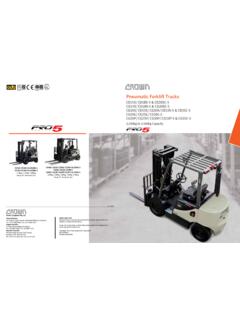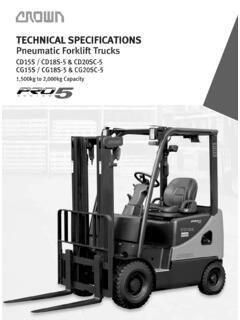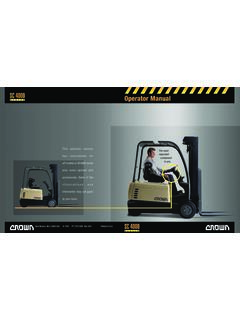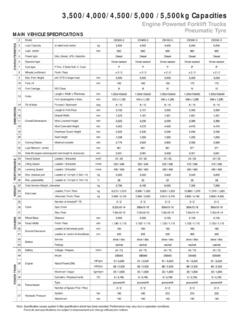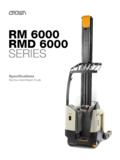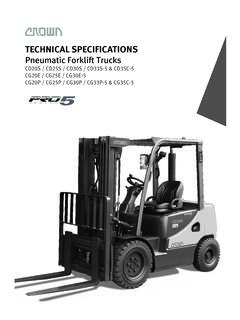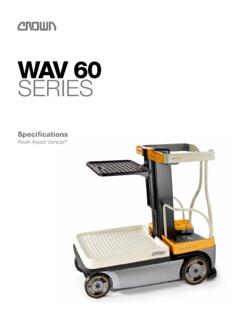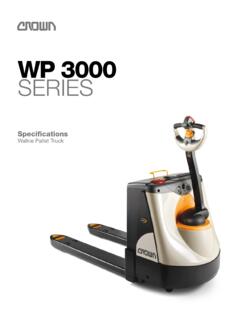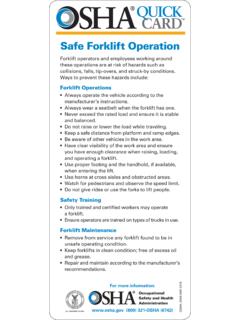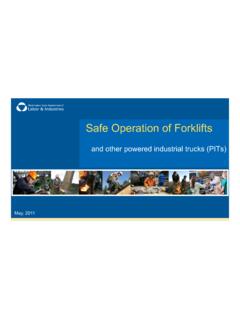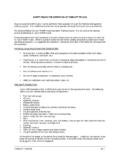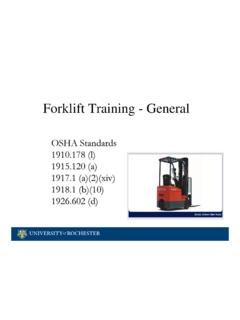Transcription of Forklift Fleet and Operator Management
1 Forklift Fleet and Operator Management : Optimizing Return through Phased Implementation Table of Contents Introduction 2. Defining Objectives 3. Reducing Fleet Costs 4. Optimizing Productivity and Improving 5. Safety Compliance with Workplace Standards Utilizing Data Effectively 7. Insights for Managers 9. Introduction Warehouse and material handling manag- compliance information, to improve This paper outlines ers continue to face pressure to reduce operational efficiency and consistency. costs and improve productivity. As with any multiple paths to Forklift continuous improvement process, informa- Despite these benefits, concerns about tion is the key to identifying and eliminating Fleet and Operator the cost and complexity of implementing waste and inefficiency.
2 A comprehensive Forklift Fleet and opera- Management based on tor Management program have kept some Forklift Fleet Management consists of the organizations from moving forward with organizational objectives. collection, analysis and use of relevant Fleet deployment. Fortunately, Fleet Management information to reduce costs and improve is not an all-or-nothing proposition. A A phased implementation Operator and truck productivity. Convenient minimal investment in a Forklift Fleet and based on high-priority access to meaningful information provides Operator Management program can provide new visibility into operations that can help a system to collect meaningful Fleet infor- objectives minimizes the answer critical questions, such as: mation.
3 Further, a company can use savings achieved from initial efforts to fund future challenges of Fleet and How much is being spent on the Fleet investments that expand the scope and each year? value of the program. Operator Management , Are costs distributed evenly or are some while still realizing the full trucks accounting for an unreasonably This information also provides a valuable high percentage of costs? window into Operator performance. benefits of the system. Through Operator log-ins, important Is the Fleet sized properly to ensure productivity metrics including average adequate capacity without having too travel time, average lift time, actual travel many trucks sitting idle?
4 Times, actual lift times, time stopped and Are all trucks and operators achieving time stopped with no Operator can similar levels of productivity? measure and benchmark individuals and groups. Are certain operators or locations accounting for a higher-than-average This paper outlines multiple paths to Forklift number of impacts? Fleet and Operator Management based on organizational objectives. A phased In addition, Fleet and Operator Management implementation based on high-priority can consolidate fragmented operations in objectives minimizes the challenges of the area of service Management and can Fleet and Operator Management while still automate processes, such as collecting realizing the full benefits of the system.
5 2. Defining Objectives Fleet and Operator Management has the Truck-mounted wireless Management potential to positively impact three of the systems (Figure 1) can provide the benefit major challenges faced by lift truck opera- of optimized truck and Operator productivity Figure 1. Vehicle- tions managers. These challenges include: by collecting information from trucks in your mounted systems Fleet and transmitting the collected information benefit both Reducing Fleet costs in real time to Management software that can operators and managers. Optimizing Operator and analyze the collected information. Wireless truck productivity Management systems can also play a role in compliancemanagement Improving compliance with through impact monitoring and workplace regulations access control.
6 Organizations that need to quickly optimize Operator While it is difficult to prioritize these and truck productivity or streamline objectives as all are critical to organizational compliance Management should success, it can be beneficial when planning for evaluate adding wireless Fleet and Operator Management to evaluate Management systems to the Fleet these objectives in light of both the potential as the most direct path toward gains that can be realized and the investment achieving objectives. required to achieve those gains. Whether you choose to begin A comprehensive service program can give with real-time information collection significant insight into costs and control over or service Management , you can those costs.
7 For organizations with a primary expand into a comprehensive interest in controlling cost, service manage- Fleet and Operator Management ment represents an ideal opportunity to take program as organizational the first steps toward Fleet Management . resources allow. 3. Reducing Fleet Costs Forklift maintenance creates the opportunity When this information is made available to against historical information to ensure ser- to collect information on the truck's Management through an online reporting vice times are consistent and appropriate, operation and represents a major component console, the information provides up-to- eliminating unexpected charges.
8 With all of total costs. Unfortunately, many date, objective support for Management trucks under Management , warranty repairs organizations are not positioned to take decisions and provides visibility into Fleet can be more effectively tracked to ensure advantage of this opportunity because costs. Vehicle replacement decisions can warranties are fully leveraged. Finally, the service is fragmented across multiple be made using actual service costs with the focus of the program can shift from a providers. This is because trucks are confidence that service is being performed reactive, break-fix mode to proactive service distributed across multiple locations and to the same standards and at the same cost that increases uptime by ensuring planned many providers only serve a limited area.
9 For all trucks in the Fleet . Operating hours maintenance is executed in a disciplined for individual trucks and the total Fleet can and consistent manner across the Fleet . When different providers service a Fleet , be analyzed to help guide decisions on the consolidation of service information is Fleet size and resource allocation. A centralized approach to service manage- more difficult and time consuming in order ment can also deliver cost-saving operational to obtain a comprehensive view of costs Not every service provider is equipped to efficiencies, through electronic invoicing and quality. In addition, the use of differ- support Fleet Management , so the choice and work order Management , that feature ent providers can introduce inconsistencies of provider is critical to the success of the integrated quality control processes to in service and parts quality.
10 One provider program. The right partner is one that can reduce processing times and minimize may use only OEM parts while another uses provide the information collection capabilities questions and disputed charges. third-party parts. Plus, there can be wide required and deliver consistent, OEM-quality discrepancies in costs for the same service across multiple locations. With the many benefits available through procedures across different vendors. service Management , it should be consid- With the right capabilities, the service ered a key component in any comprehen- Centralizing service Management using Management program can play a significant sive Fleet Management program and often a single network of providers with known role in reducing costs.
